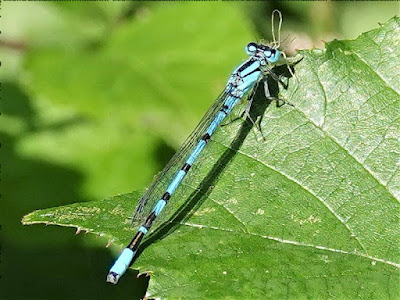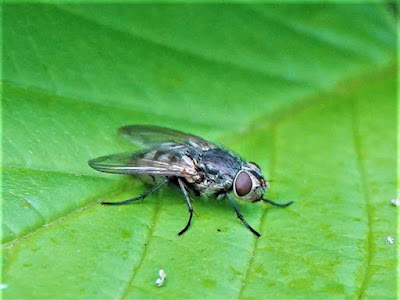13.0°C > 18.0°C: A few early patches of cloud soon cleared: sunny for a while; cloud increased steadily after 07:45. Moderate south-westerly breeze. Feeling much fresher. Excellent visibility.
Sunrise: 04:47 BST
* = a species photographed today.
+ = my first sighting of this species at this site this year.
++ = new species for me at this site.
Priorslee Balancing Lake: 04:45 – 06:15 // 07:20 – 09:40
* = a species photographed today.
+ = my first sighting of this species at this site this year.
++ = new species for me at this site.
Priorslee Balancing Lake: 04:45 – 06:15 // 07:20 – 09:40
(138th visit of the year)
Bird notes:
- Certainly two Garden Warbler singing concurrently. Neither I nor my app were sure about a possible third bird. It seemed to sing like both species, staying invisible in the fully-leaved trees. We both kept changing our minds about which species it was.
Birds noted flying over here:
- 9 Mallard: three groups
- 2 Stock Doves: together
- 29 Wood Pigeons
- 1 Jackdaw
- 1 Rook
That's all folks!
Warblers noted (the number singing in brackets):
- 1 (1) Cetti's Warbler
- 1 (1) Willow Warbler
- 12 (12) Chiffchaffs
- 9 (9) Reed Warblers
- 12 (10) Blackcaps
- 2 (3?) (2 (3?)) Garden Warblers: see notes
- 2 (1) Common Whitethroats
Hirundines etc., noted:
- 12 Swifts: early only
- 1 House Martin
Counts from the lake area:
- 2 + 2 Mute Swans
- 7 (?♂) Mallard
- 2 Moorhens
- 26 + 33 (? broods) Coots
- *9 + 3 (1 brood) Great Crested Grebes
- 1 Grey Heron: somewhat unusually stayed throughout
On and around the street lamp poles around dawn:
Bird notes:
- Certainly two Garden Warbler singing concurrently. Neither I nor my app were sure about a possible third bird. It seemed to sing like both species, staying invisible in the fully-leaved trees. We both kept changing our minds about which species it was.
Birds noted flying over here:
- 9 Mallard: three groups
- 2 Stock Doves: together
- 29 Wood Pigeons
- 1 Jackdaw
- 1 Rook
That's all folks!
Warblers noted (the number singing in brackets):
- 1 (1) Cetti's Warbler
- 1 (1) Willow Warbler
- 12 (12) Chiffchaffs
- 9 (9) Reed Warblers
- 12 (10) Blackcaps
- 2 (3?) (2 (3?)) Garden Warblers: see notes
- 2 (1) Common Whitethroats
Hirundines etc., noted:
- 12 Swifts: early only
- 1 House Martin
Counts from the lake area:
- 2 + 2 Mute Swans
- 7 (?♂) Mallard
- 2 Moorhens
- 26 + 33 (? broods) Coots
- *9 + 3 (1 brood) Great Crested Grebes
- 1 Grey Heron: somewhat unusually stayed throughout
On and around the street lamp poles around dawn:
Nothing noted
Noted later in cooler, often cloudy and breezy conditions:
Butterflies:
- *Large Skipper (Ochlodes sylvanus)
- Ringlet (Aphantopus hyperantus)
Moths:
- Timothy Tortrix (Zelotherses paleana)
- Common Marble (Celypha lacunana)
Bees / wasps etc.:
- Honey Bee (Apis mellifera)
- Garden Bumblebee (Bombus hortorum)
- Common Carder Bee (Bombus pascuorum)
- *Early Bumblebee (Bombus pratorum)
- Common Wasp (Paravespula vulgaris)
Hoverflies:
- Bumblebee Blacklet (Cheilosia illustrata)
- *Marmalade Hoverfly (Episyrphus balteatus)
- *Stripe-faced Dronefly (Eristalis nemorum)
- Common Spotted Field Syrph (Eupeodes luniger)
- Common Twist-tail (Sphaerophoria scripta)
- *Chequered Hoverfly (Melanostoma scalare)
- *Syrphus sp. (S. ribesii / S. vitripennis)
- +*Pellucid Fly (Volucella pellucens) [Pied Plumehorn]
Dragon-/damsel-flies:
- *Common Blue Damselfly (Enallagma cyathigerum)
- Blue-tailed Damselfly (Ischnura elegans)
Other flies:
- *Black Snipefly (Chrysopilus cristatus)
- *semaphore fly Poecilobothrus nobilitatus
- *unidentified fly
Beetles:
- Alder Leaf Beetle (Agelastica alni): adults and larvae
Bugs:
- 7 Spot Ladybird (Coccinella 7-punctata): larva only
Also
- White-lipped Snail (Cepaea hortensis)
Noted later in cooler, often cloudy and breezy conditions:
Butterflies:
- *Large Skipper (Ochlodes sylvanus)
- Ringlet (Aphantopus hyperantus)
Moths:
- Timothy Tortrix (Zelotherses paleana)
- Common Marble (Celypha lacunana)
Bees / wasps etc.:
- Honey Bee (Apis mellifera)
- Garden Bumblebee (Bombus hortorum)
- Common Carder Bee (Bombus pascuorum)
- *Early Bumblebee (Bombus pratorum)
- Common Wasp (Paravespula vulgaris)
Hoverflies:
- Bumblebee Blacklet (Cheilosia illustrata)
- *Marmalade Hoverfly (Episyrphus balteatus)
- *Stripe-faced Dronefly (Eristalis nemorum)
- Common Spotted Field Syrph (Eupeodes luniger)
- Common Twist-tail (Sphaerophoria scripta)
- *Chequered Hoverfly (Melanostoma scalare)
- *Syrphus sp. (S. ribesii / S. vitripennis)
- +*Pellucid Fly (Volucella pellucens) [Pied Plumehorn]
Dragon-/damsel-flies:
- *Common Blue Damselfly (Enallagma cyathigerum)
- Blue-tailed Damselfly (Ischnura elegans)
Other flies:
- *Black Snipefly (Chrysopilus cristatus)
- *semaphore fly Poecilobothrus nobilitatus
- *unidentified fly
Beetles:
- Alder Leaf Beetle (Agelastica alni): adults and larvae
Bugs:
- 7 Spot Ladybird (Coccinella 7-punctata): larva only
Also
- White-lipped Snail (Cepaea hortensis)
- *Common Frog (Rana temporaria)
Strange: more colour in the reflection than the sky at dawn.
Food for the youngsters. The Great Crested Grebes have no trouble finding food.
Another rather worn-looking male Large Skipper (Ochlodes sylvanus).
Still cool in the breeze and this Early Bumblebee (Bombus pratorum) was still sleeping.
As was this one.
This is what I believe to be a Stripe-faced Dronefly (Eristalis nemorum). The orange markings are not diagnostic of any of the Eristalis species and this view does not afford a view of the Stripe-face. My identification is based on the body-shape combined with the white margins between the body segments and lack of any shading in the wing.
Yesterday was the first flower of Bistort (Polygonum bistorta). A Marmalade Hoverfly (Episyrphus balteatus) is already taking advantage of the nectar on offer.
Another hoverfly in flight: the somewhat triangular yellow marking indicate this is a female Chequered Hoverfly (Melanostoma scalare).
Another hoverfly feeding, here on Meadowsweet (Filipendula ulmaria). The hoverfly is one of the Syrphus ribesii / S. vitripennis) species pair. As always it is a male and so the colour of rear legs does not help.
What my logs suggest is my first Pellucid Fly (Volucella pellucens) [also known as Pied Plumehorn] this year. I often see this species in May so have I overlooked it? It is a striking insect and hard to overlook.
My random photos of 'blue' damselflies are still only finding Common Blue Damselflies (Enallagma cyathigerum).
Only my second sighting this year of a female Black Snipefly (Chrysopilus cristatus).
And the more numerous male.
A female of the Semaphore fly Poecilobothrus nobilitatus. She lacks the white tips to the wings that the male possesses.
Today's unidentified fly.
This tiny frog wants to know the time – it is on my watch-strap (watch and strap £15 from Argos 10 years ago).
Plane of the day: this is a Boeing 747-4B5F operated by Kalitta Air. It is being operated on behalf of United Arab Emirates flying between Chicago and Brussels. This 22-year old aircraft was built as a freighter for Korean Airlines. It has been with Kalitta since 2017. Kalitta's operating base is at Ypsilanti near Detroit. They specialise in contract freight hauling and for many years operated end-of-life aircraft with 'basic' livery. Recently they have won contracts operating for DHL and have purchased new aircraft.
(Ed Wilson)
------------------------------------------------------------------------------------------------------
The Flash: 06:20 – 07:15
(127th visit of the year)
Bird notes:
- A late brood of nine Mallard ducklings. Late broods tend to survive better as the drakes' testosterone has diminished and they no longer pester the ducks.
- Just one Great Crested Grebe seen in the water. The area where I thought yesterday there might be a revisited nest was swarming with geese climbing on the island.
- [I was told a Grey Heron had been seen pursuing juvenile Coots earlier]
Birds noted flying over here:
None
Warblers noted (the number singing in brackets):
- 6 (6) Chiffchaffs
- 2 (2) Blackcap
Hirundines etc., noted:
- >20 Swifts
- 2 House Martins
Noted on / around the water
- 149 Canada Geese
- 64 Greylag Geese
- 2 + 4 Mute Swans
- *18 (?♂) + 9 (1 brood) Mallard
- 6 (6♂) Tufted Duck
- 5 + 2 (1 brood) Moorhens
- 24 + 10 (4 broods) Coots
- 1 Great Crested Grebe
On / around the street lamp poles around the water:
Warblers noted (the number singing in brackets):
- 6 (6) Chiffchaffs
- 2 (2) Blackcap
Hirundines etc., noted:
- >20 Swifts
- 2 House Martins
Noted on / around the water
- 149 Canada Geese
- 64 Greylag Geese
- 2 + 4 Mute Swans
- *18 (?♂) + 9 (1 brood) Mallard
- 6 (6♂) Tufted Duck
- 5 + 2 (1 brood) Moorhens
- 24 + 10 (4 broods) Coots
- 1 Great Crested Grebe
On / around the street lamp poles around the water:
Nothing noted
Noted elsewhere around The Flash:
- ++*Small Magpie moth (Anania hortulata)
- *Single-dotted Wave moth (Idaea dimidiata)
- Common Wasp (Paravespula vulgaris)
- Marmalade Hoverfly (Episyrphus balteatus)
- Tapered Drone Fly (Eristalis pertinax)
- +Bumblebee Plume-horned Hoverfly (Volucella bombylans)
- Common Blue Damselfly (Enallagma cyathigerum)
- Alder Leaf Beetle (Agelastica alni): adults and larvae
Noted elsewhere around The Flash:
- ++*Small Magpie moth (Anania hortulata)
- *Single-dotted Wave moth (Idaea dimidiata)
- Common Wasp (Paravespula vulgaris)
- Marmalade Hoverfly (Episyrphus balteatus)
- Tapered Drone Fly (Eristalis pertinax)
- +Bumblebee Plume-horned Hoverfly (Volucella bombylans)
- Common Blue Damselfly (Enallagma cyathigerum)
- Alder Leaf Beetle (Agelastica alni): adults and larvae
This is a large brood to look after: nine ducklings for this Mallard.
A Small Magpie moth (Anania hortulata). A moth that is easily flushed during the day. The Wet Midlands moth site has it as the third most-likely micro-moth to be seen on this date. Notwithstanding this it is my first record here.
This is a Single-dotted Wave moth (Idaea dimidiata). It flushed from the grass and hid under a leaf. I was amazed that it allowed me to turn the leaf over and look at it.
(Ed Wilson)
------------------------------------------------------------------------------------------------------
- *1 Little Grey (Eudonia lacustrata) on a street lamp pole.
- ++*possible Large Yellow Foxglove (Digitalis grandiflora): an escape?
'Greys' are a confusing group of moths. I think this is a Little Grey (Eudonia lacustrata).
It looks a bit like a pale Foxglove and probably is. My PlantNet app suggested it was a Giant Foxglove (Digitalis grandiflora). My Flora gives the vernacular name for the scientific name as Large Yellow Foxglove and notes that it is naturalised in the UK. Here it may be nothing more than a garden escape. It is very pale yellow it seems!
(Ed Wilson)
------------------------------------------------------------------------------------------------------
On this day can be found via the yearly links in the right-hand column.
Sightings from previous years without links are below
2013
Priorslee Lake
Grasshopper Warbler
(Ed Wilson)
2012
Priorslee Lake
Special this morning was rather bizarre: an all-white, apparently albino, Budgerigar(!) sheltering in the copse between the football field and the playground!
(Ed Wilson)
2008
Priorslee Lake
Common Sandpiper
Another slight puzzle this morning. It sounded like a 'Blackcap with a difference' with an extended song with lots more variety than usual and many notes recalling Garden Warbler, Song Thrush and Blackbird. It was clearly NOT the bird from earlier but I was curious. It was always singing well above head-height (Acros tend to be below head-height) and never had the rhythm of an Acro but the long and flowing song was very strange (and very loud). In the end the bird gave itself up and proved to be what I thought - a 'Blackcap with a difference' - lots of testosterone? It proved my 'rule of thumb' - if you are not sure whether it is a Blackcap or a Garden Warbler it is a Blackcap.
(Ed Wilson)





















